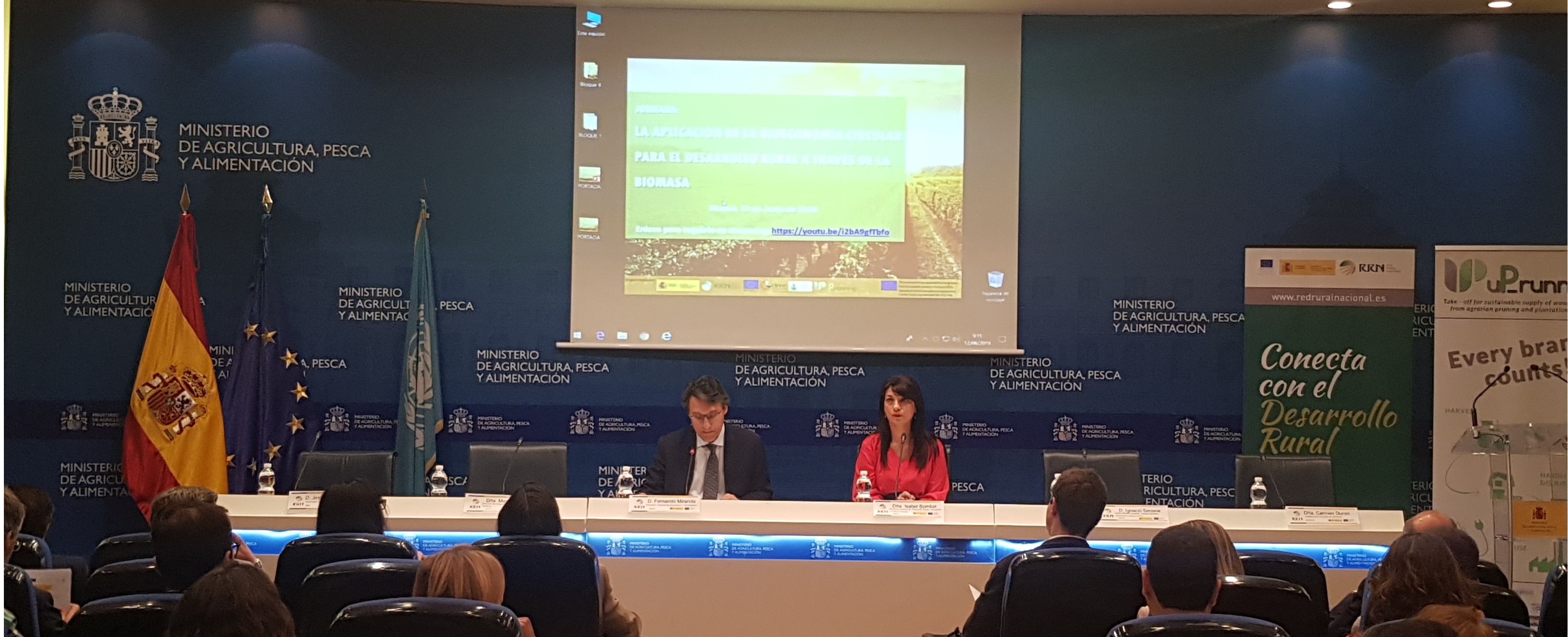
14 de June de 2019
Dinamización rural
Cambio climático y gestión de recursos naturales
The bioeconomy (as a transdiscipline that seeks to maximize the use of renewable resources of biological origin, and especially to maximize the value of byproducts, for use in food, human and animal nutrition, energy, and the production of all types of high-value biological products) is experiencing a significant momentum and is "here to stay." This conference delved into the current situation and future.
June 13, 2019
In recent years, various strategic and political frameworks have made explicit mention of the bioeconomy. For example, it is associated with the achievement of at least 11 of the 17 Sustainable Development Goals (SDGs) of the UN's 2030 Agenda , it appears as a specific objective of the new post-2020 CAP, it has an ad hoc European Strategy , and it is expressly included among the priorities of the future European R&D&I policy.
In this context, the conference on " The Application of the Circular Bioeconomy for Rural Development through Biomass " highlighted this favorable political context and highlighted how much is being done in Spain, across different regions and sectors, to take advantage of the opportunities offered by the bioeconomy.
The Ministry of Agriculture, Fisheries and Food has highlighted the current key moment in the strategic planning of the post-2020 CAP , and how all stakeholders must view the bioeconomy as both an opportunity and a necessity to be addressed.
During the conference, the importance of biomass as a key element in the bioeconomy was highlighted, taking on a strategic role in reducing the current dependence on fossil fuels, but also in its impact on the fight against climate change. In this context, the 2018 update of the European Union's Bioeconomy Strategy , the 2015 Spanish Bioeconomy Strategy , the strategies and plans that the regional governments are developing in their territories, and the funds allocated to R&D&I in the bioeconomy in the current EU Horizon 2020 program and the future Horizon Europe 2021-2027 program have served to contextualize the actions being carried out in the area of the bioeconomy at the European, national, and regional levels.
Furthermore, the need to review and relaunch the Spanish Bioeconomy Strategy has been highlighted, as has been done with the European Strategy, in order to give it a greater environmental focus on the circular bioeconomy, and also to give greater prominence to primary producers, as well as to the bioeconomy planning efforts that are emerging at the regional and local levels. A new, revised Spanish Bioeconomy Strategy will be able to focus especially on the most relevant and interesting topics for the agri-food and forestry sectors, such as the use of agricultural and forestry biomass for both industrial and energy purposes, the valorization of waste and by-products from the agricultural and forestry sectors, the reduction of food waste and the development of biodegradable bioplastics, as well as the use of reclaimed water for irrigation.
Probably the best part of the event came from the key players on the ground, who shared practical experiences, success stories, and initiatives from across Spain centered around the bioeconomy. They highlighted the economic, social, and environmental benefits this transdisciplinary approach can generate in the productive sectors, especially the agri-food and rural forestry sectors.
One of the initiatives to which the most time was dedicated was a pan-European Horizon 2020 project called "uP_running , " in which ASAJA Huesca and the Circe Technology Center participated. The work carried out aims to unlock the European potential of woody biomass residues produced by Agricultural Pruning and Plantation Renewal (PARP) and promote their sustainable use as an energy feedstock. The objective of this initiative is to demonstrate and produce key tools to convince stakeholders to participate in PARP value chains and, ultimately, to scale up the use of PARP through the involvement of multiple local stakeholders in seven EU countries.
In addition, other projects on circular bioeconomy related to the use of forest and agricultural biomass, the use of biofuels, biorefineries or waste recovery have been presented, projects presented by Agri-Food Cooperatives of Spain, the Union of Small Farmers (UPA), supra-regional operational innovation groups financed by the National Rural Development Program 2014-2020 and other entities ( ENCE , Vilafranca del Penedés City Council , Athisa biogeneration , Basque Energy Agency and AVEBIOM ). They agree on promoting collaboration between the agroforestry and technological sectors, establishing synergies that allow the launch of pilot projects.
The holding of the conference on June 12, 2019, at the headquarters of the Ministry of Agriculture, Fisheries and Food, has therefore allowed for a deeper understanding of the role that the bioeconomy plays in the agricultural and forestry sector in rural areas, as well as the opportunities it offers as a driver of economic activity. It was organized by the Ministry through the General Directorate of Rural Development, Innovation and Forestry Policy, specifically the Subdirectorate General of Innovation and Digitalization, which is the unit with responsibilities in bioeconomy. The agricultural organization ASAJA and the Center for Research on Energy Resources and Consumption (CIRCE) were also co-organizers, making this meeting possible thanks to the work of the National Rural Network .









